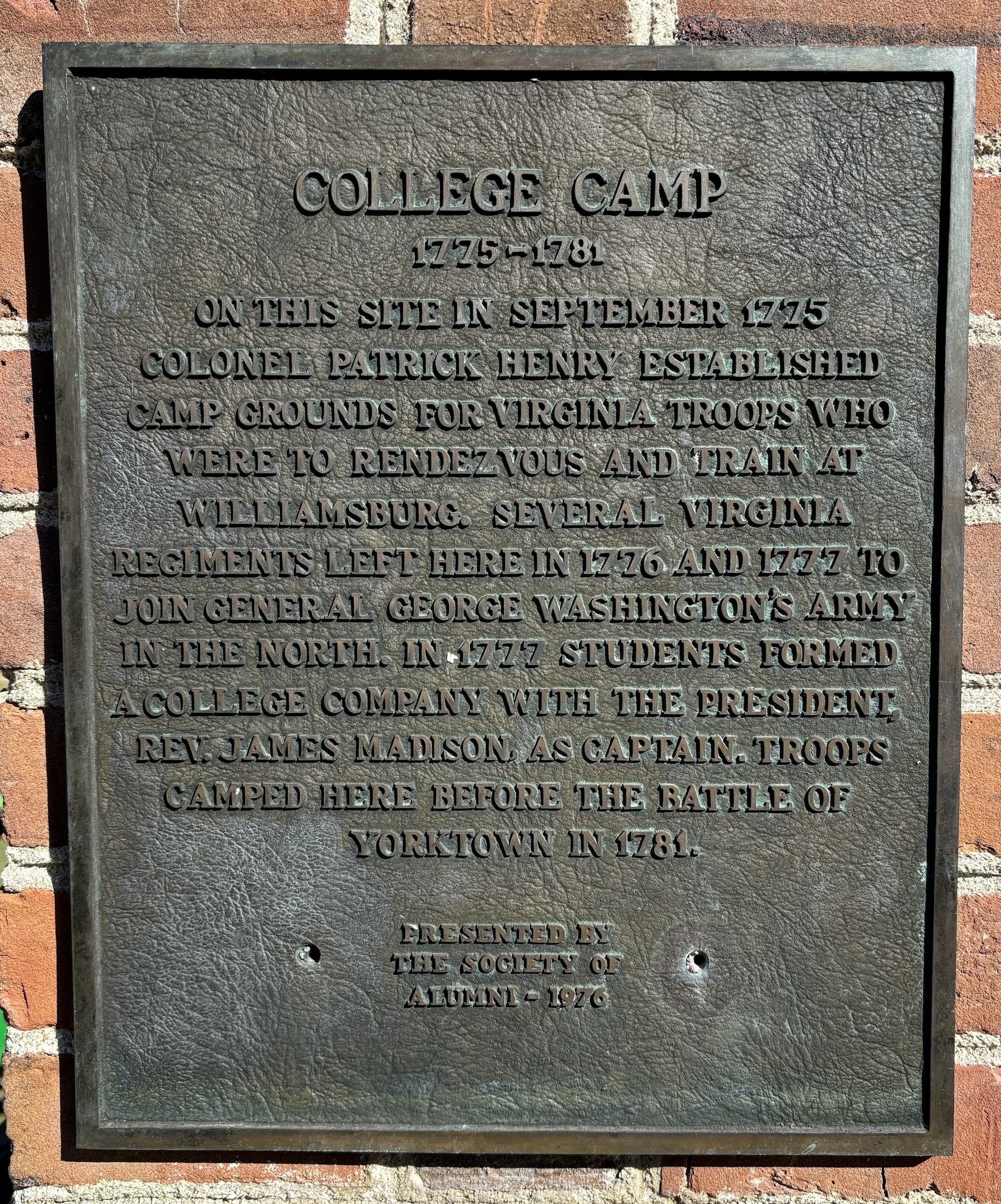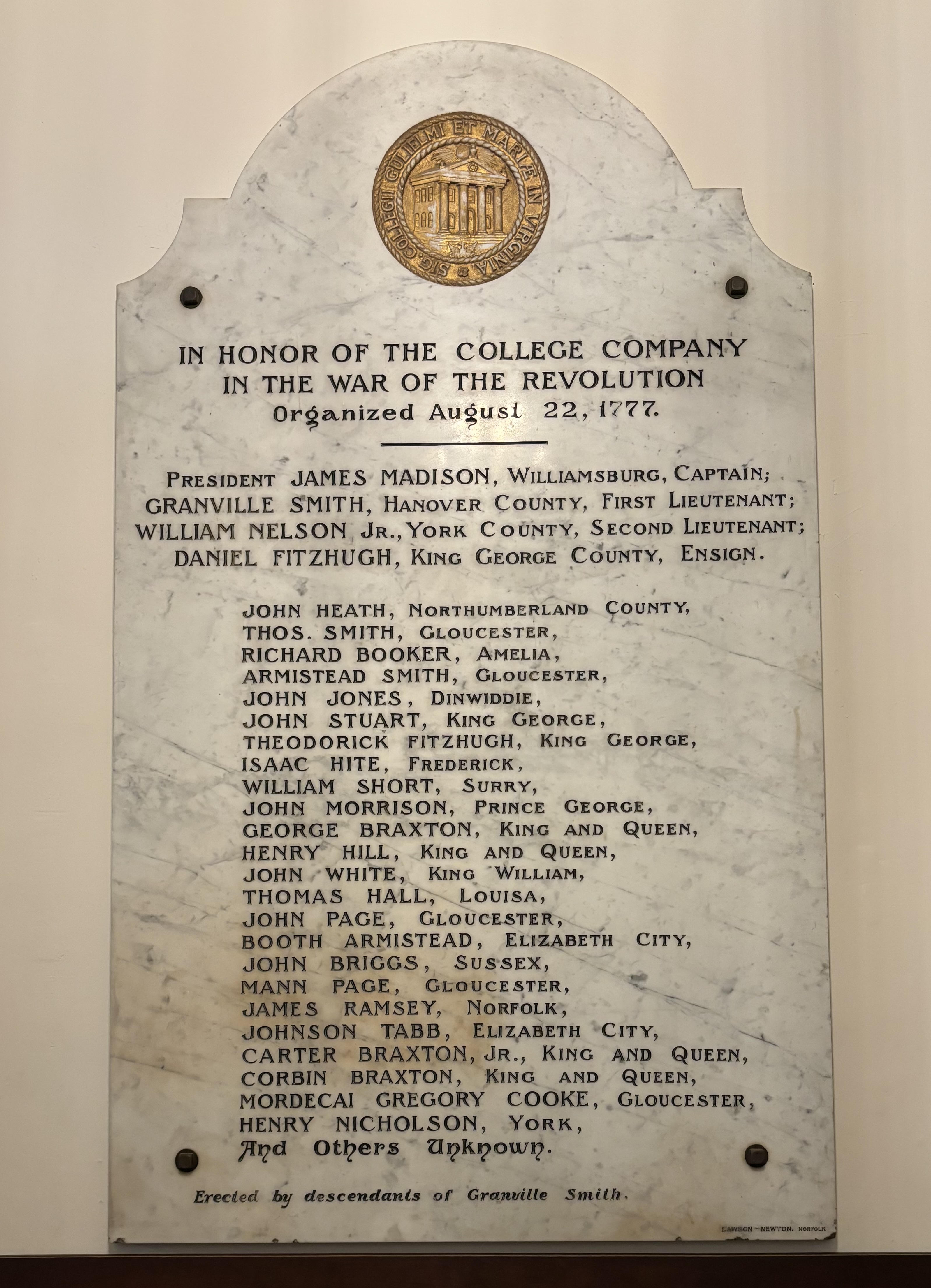As the country prepares to observe the 250th anniversary of the opening salvos of the American Revolution, William & Mary reflects on the long tradition of student military service to the nation exemplified by the College Company.
Throughout the 18th century, William & Mary students and graduates often served in their local militias, particularly during the Seven Years’ War in the 1750s and 1760s, although Virginia’s General Assembly exempted students and faculty from mandatory military service. However, with the first rumblings of revolution in April 1775 and in the aftermath of an order by Virginia’s royal governor, Lord Dunmore, to remove arms, powder and ammunition from the Williamsburg powder magazine, students increasingly left their studies to join their home militias or enlist in units raised in and around Williamsburg. As Wilford Kale ’66, P ’19 recounted in his book “From Student to Warrior: A Military History of The College of William and Mary” (2017), some joined the Williamsburg Volunteers, led by recent graduate and militia captain James Innes, who also recruited students for an artillery company. Several other students and graduates left in the ensuing two years for commissions in the Continental Army.

After being named colonel of the 1st Virginia Regiment, Patrick Henry established the College Camp in October 1775 and ordered all Virginia county militia and minutemen to report for training. Although originally identified as being in the vicinity of today’s Sunken Garden (as noted by the bicentennial plaque at the east entrance), it is now believed the camp was located near present-day Kaplan Arena. William & Mary students would have been in this encampment as members of various units. The College Company, which inspired both the “Revolutionary Guard Battalion” moniker of William & Mary’s Reserve Officer Training Corps (ROTC) unit and the alumni affinity group the Association of 1775 (Ao75), was not an officially endorsed entity in the early years of the war. This changed at the Monday, Aug. 18, 1777, meeting of the Council of Virginia when the members issued the following decree, as reported in the Council’s journals and the Virginia Gazette: “The Governor [Patrick Henry], with the advice of the Council, issued Commissions appointing, the Reverend Mr James Madison Captain, Granville Smith first Lieutenant, William Nelson second Lieutenant and Daniel Fitzhugh Ensign of a Company of Militia formed out of the Students of William and Mary College.” The Rev. James Madison (cousin of Constitution author and future president James Madison) was the recently appointed president of W&M after President John Camm was ousted for his Loyalist affinities. The company leadership and original 24 members are commemorated on a marble plaque in the Wren Building atrium.
The College Company participated in four documented actions during the Revolution. When British forces threatened seaborne assaults in the Norfolk, Hampton Roads and Southside areas in August 1777 and May 1779, the Company organized to respond, in the latter case moving to Smithfield in anticipation of a British attack up the James River. In the spring of 1781, American-turned-British Gen. Benedict Arnold stationed troops in Williamsburg in support of Gen. Charles Cornwallis’ change of base to Yorktown. One day in April, members of the College Company took positions behind trees and shrubs at the intersection in front of the Wren Building (today’s Richmond and Jamestown Roads and Boundary Street) and fired shots at some of Arnold’s troops moving nearby. No battle developed from this altercation, but the rapidly developing strategic situation on the Peninsula and around Yorktown drove Madison to close William & Mary’s doors on June 1, 1781, as there were few students and faculty left. The Company joined other militia and Continental troops at Yorktown by late summer and was present for the siege of the city and Cornwallis’ surrender. Because of this participation, the Revolutionary Guard Battalion is authorized to place the U.S. Army campaign streamer for Yorktown on its colors.

The only other time the College Company formed was in January 1861, when secession-minded students, soon joined by many faculty, anticipated defending their interests against the U.S. Army. After the Civil War, students took more traditional pathways into the U.S. military, but homegrown organizations inspired by current events formed at specific times. For example, days after the United States declared war on Germany in April 1917, students and faculty voluntarily organized a battalion that drilled each afternoon on campus. Other students took part in the College’s Flight Club, formed by students in the and aeronautics department instituted by President J.A.C. Chandler 1891, M.A. 1892, P 1920, P ’34, P ’63, G ’48, G ’49, G ’50 in the early 1930s. In 1947, William & Mary’s Army ROTC unit activated, and many of its alumni went on to distinguished careers in the U.S. military and government.
Graduates formed Ao1775 in 1992 to foster a spirit of continued service to W&M and the nation. In 2016, a group of Army ROTC alumni reimagined Ao1775 as an affinity group for not only active duty and veteran alumni, but all alumni who serve or have served in any sector of the federal government. Aided by a $10 million gift from an alumna in 2020, William & Mary established its Veteran-to-Executive Transition program (W&M VET) which helps organize and coordinate the college’s various veteran-focused organizations to include Ao1775 and the Center for Military Transition at the Raymond A. Mason School of Business, to name just two. With President Katherine A. Rowe’s focus and commitment to supporting military student and veteran education and transition pathways, William & Mary is well positioned to continue its tradition of military and public service to the nation as it looks forward to the next 250 years.
Brit Erslev ’97 was a history major and member of the Revolutionary Guard Battalion. She retired from the U.S. Army in 2024 and is a member of the Association of 1775, the W&M Alumni Association’s network for military/veteran and federal government alumni.
Charles Bowery ’92 is president of the Association of 1775 and executive director of the U.S. Army Center of Military History. He is a retired U.S. Army colonel and was a member of the Revolutionary Guard Battalion.
Sources:
Kale, Wilford. From Student to Warrior: A Military History of The College of William and Mary. Williamsburg, VA: Botetourt Press, 2017.
Selby, John E. The Revolution in Virginia, 1775-1783. Williamsburg, VA: The Colonial Williamsburg Foundation, 1988.
Journals of the Council of Virginia
Virginia Gazette (various)